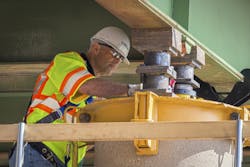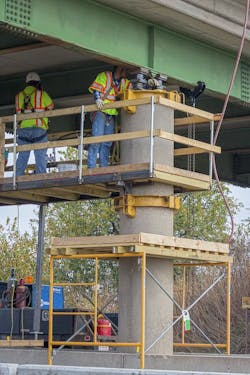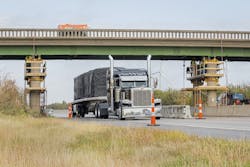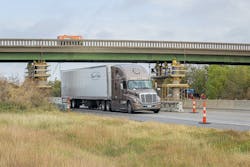Contractor raises Kansas bridges using hydraulic jacking approach
As our nation’s transportation infrastructure continues to evolve, it is important to ask: Can we afford the investment to meet future needs by following the same old ideas and assumptions?
In many cases, our roads and bridges were built with a vision that reflected realities that are now quickly changing. More and more reports point out the fact that much of our transportation infrastructure has reached or exceeded its original design life and intended use. A new vision of the future is required, and that includes new project delivery approaches.
One recent Burns & McDonnell project used a “first-ever” approach to project execution for traditional transportation infrastructure that can serve as an illustration of what the future may increasingly look like.
Reuse instead of replace
By late 2015, the Kansas Turnpike Authority (KTA) faced a dilemma: Much of its aging infrastructure was coming to the end of its useful life. KTA developed a 10-year program to preserve, modernize, and enhance the system. But with so much work needed and a desire by KTA to cash flow projects, a way was needed to stretch resources.
Among the projects slated for funding was the need to raise bridges on I-35 and I-335, along a 180-mile stretch between Topeka and the Oklahoma state line. KTA needed to raise the vertical clearance of many of its bridges along this corridor by 12 to 21 in. to accommodate oversized loads, which are increasingly common on today’s highways. These trucks were being regularly rerouted around KTA facilities because they could not fit under the bridges. It was both a safety problem and a nuisance to freight traffic, and it resulted in significant lost revenue for the turnpike authority.
After analyzing the problem, Burns & McDonnell had an idea. Instead of conventional bridge repair methods that could include replacements, the firm suggested using a system of hydraulic jacks to simply raise the bridges, leaving the original concrete and steel structures intact. The savings would run into many millions of dollars, all while the work could be completed under live traffic, thus limiting the impact to turnpike users.
After modeling and testing the proposed solution, the team finalized a plan to utilize a system of hydraulic jacks to slowly and carefully lift the bridges off their original concrete piers. With many of the bridges weighing as much as 300 tons, it needed to be a meticulous and carefully planned process.
The project involved raising bridges—some were as low as 14 ft—to a minimum height of 15 ft, 9 in. For each bridge, the construction team used up to 20 hydraulic jacks to carefully push up to 600,000 lb of steel girders and concrete deck upward, 1 in. at a time. Within eight hours of jacking, shimming, inspecting, and repeating, the bridges rested on new bearings, secured with steel anchor bolts.
Then, bridge approaches at both ends were regraded, with new guardrails installed and new road signs posted. The project concept has avoided the need for new rights-of-way, easements, or utility relocations.
Alternative project delivery
While evaluating and testing the proposed project concept, the team also suggested another first: executing the project with an engineer-procure-construct (EPC) delivery approach. No transportation project in Kansas had previously been executed under the EPC contract approach the team presented.
Because of the flexibility inherent under EPC, the team was able to outline a number of additional savings that could be achieved, primarily due to faster construction schedules with a dedicated team of locally based construction contractors.
The KTA selected the Burns & McDonnell team because of the firm’s ability to cut project costs and reduce the schedule. Under a conventional design-bid-build contract method, approximately twice the time would have been needed for this project scope.
The design and construction teams worked together to develop the preliminary design, then carefully evaluated multiple subcontractors. This approach enabled a turnkey solution with fewer issues related to schedule, budget, and available resources. Within four months of the first design meeting, the team was able to set a guaranteed maximum price of $3.7 million, far below initial cost projections.
As part of the EPC process, the project team continued to identify ways to provide value during construction and identified significant savings in earthwork grading, haul road maintenance, and customized safety equipment. In the end, the team returned enough shared savings to KTA to raise an additional bridge within the original budget.
Under the now-completed first and second phases, 22 overpass bridges have been raised along the I-35 and I-335 portions of the Kansas Turnpike from Topeka to south of Wichita, and a third phase is now underway. Phases 1 and 2 were delivered more than six months ahead of schedule with cost savings exceeding $3 million from initial cost projections.
Perhaps most important, the first phases were completed with zero safety recordables spanning more than 100,000 man-hours.
The future requires innovation
There is no question that public transportation faces a future of limited resources and heightened public scrutiny. As funding and resources become more limited, demand for new services is growing, and legacy infrastructure continues to deteriorate. Innovation is needed like never before.
We can expect disruption and massive transformation in the transportation industry in the future. But this uncertain future presents an opportunity for us to think beyond traditional design and delivery methods. Projects like the KTA’s bridge-raising program prove that innovative approaches are needed to create the best path forward.




